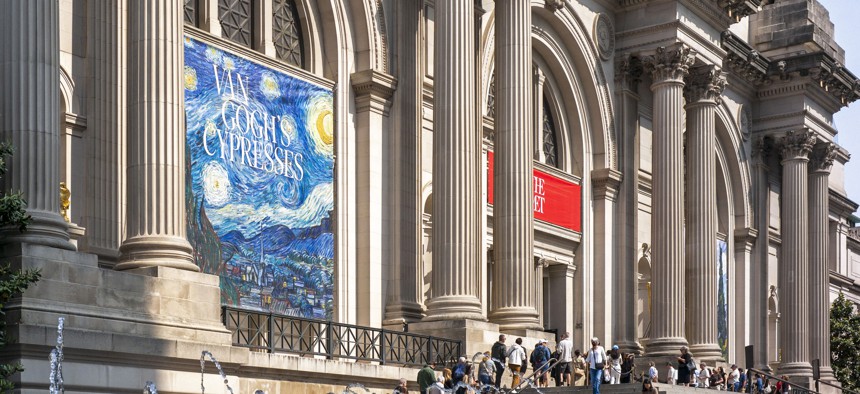Opinion: New Yorkers deserve their free museums and other cultural venues
A proposed study will examine why 17 institutions operating rent-free in either city owned buildings or park land in exchange for offering free admissions to city residents aren’t living up to their promise.

People line up to enter the Metropolitan Museum of Art for the media preview of "Van Gogh's Cypresses" exhibition on May 15, 2023. Photo by Wang Fan/China News Service/VCG via Getty Images
Seventeen of our city’s most spectacular museums, zoos, botanical gardens, science and performing arts centers, as well as the New York Aquarium, have founding laws or contracts that require free admission for New Yorkers, attributable to a public-private partnership dating back to the mid-19th century. The partnership provided rent-free use of parkland and buildings to the institutions in exchange for free admission and instruction for New Yorkers.
However, the facts of New Yorkers’ rights are ambiguous because city leaders have over the last 150 years obscured the provisions of controlling laws and contracts. Currently, city leaders subsidize these institutions with $1 billion in free rent, admission fees and operating and capital costs every year, while New Yorkers are obliged to pay a fixed or pay-what-you-wish (but you must pay something) admission fee.
The time is now for New Yorkers to insist that city and state authorities codify, publish and enforce the provisions of the public-private partnership. Among the institutions sharing in New York City taxpayers’ $1 billion annual subsidy, despite evading their agreement to provide free admission, are the American Museum of Natural History, Brooklyn Children’s Museum, Central Park Zoo, New York Botanical Garden, Queens Zoo, Metropolitan Museum of Art, Brooklyn Academy of Music, Brooklyn Museum, Museum of the City of New York , New York Hall of Science, Staten Island Museum, Wave Hill, Brooklyn Botanic Garden, Bronx Zoo, New York Aquarium, Prospect Park Zoo and Staten Island Zoo.
The Metropolitan Museum of Art and the American Museum of Natural History were the two inaugural projects of the public-private partnership. The terms for the general public’s free admission were similar and stated in the MMA’s 1878 Lease as follows: “. . . the exhibition halls of said building shall . . . on Wednesday, Thursday, Friday and Saturday of each week, and on all legal and public holidays except Sundays, be kept open and accessible to the public, free of charge.” Additionally, the MMA was to provide free access to teachers and professors from our city’s public schools and institutions where instruction was provided for free during all operating hours. For the added 15 park institutions, comparable terms were written into their founding state legislation or initiating local laws and contracts.
The MMA was the first to institute a pay-what-you-wish-but-you-must-pay-something policy, contravening the terms of its 1878 lease and kicking off a trend among the 17 institutions to require payment for entry. According to The New York Times, The MMA “argued in court that a 1970 agreement with the city gave it the power to charge [a fee], though that power was never written into its lease,” meaning the MMA has in effect operated for more than 50 years in violation of its lease with the city.
Today, according to the institutions’ consolidated 2017-2018 and 2019 audited financial statements and/or IRS 990 forms, New Yorkers pay an estimated $112.5 million in admission fees every year to the 17 institutions, in addition to $172.2 million and $59.4 million to fund their operating and capital costs, respectively. Based on a conservative estimate of COVID-19-impacted rent pricing, the city forfeited more than $700 million in rent which, if not forgiven but instead was paid, could be used to fund other priorities for New Yorkers. In 2012, I sued the MMA for its misleading admissions policies after discovering its 1878 lease. My suit was dismissed, but only because the judge determined that I, as a tax-paying New Yorker, did not have standing to sue the museum – this power resides only with the city, the state and the 17 institutions, according to the city’s Corporation Counsel.
The need for a forensic review and codification of controlling laws and contracts is pressing. That is why we at the Free Admission campaign worked with Assemblyman Charles D. Fall to introduce Assembly Bill #A03059 and State Senator Cordell Cleare to introduce Senate Bill #S5265. The bills direct the Department of Economic Development, in conjunction with New York City’s Parks Department and Department of Cultural Affairs, to conduct a study regarding public access to the 17 park institutions, to disclose the admissions fees they collect from New Yorkers and the subsidies, including the value of any form of free rent, they receive from the public.
It is also why we urge all New Yorkers to sign a petition in support of Bill #A03059 to let New York’s legislators know that we appreciate their efforts to determine, codify and publicize the facts of our rights to free admission and instruction. Further delay is only costing New Yorkers the right they have to access these great institutions.
Patricia Nicholson is the founder of Free Admission, a campaign to enforce contracts and laws providing New Yorkers free of charge admission to 17 institutions across New York City.
NEXT STORY: Opinion: The problem with plea bargains and how NY can help the innocent

